During Which Era Did Mammals Become The Dominant Land Animals?
Mammal Evolution: Part Four of our Ultimate Guide to Mammals.
Other pages in this serial:
- Part I: Mammals: An Introduction
- Part Ii:What Is A Mammal?
- Role Three:Types of Mammal
- Is a bird a mammal?
- Are sharks mammals?
- Is a dolphin a mammal?
On this page, we're going to become dorsum in time in order to meet the very start mammals and their ancestors.
The Evolution of Mammals: Introduction
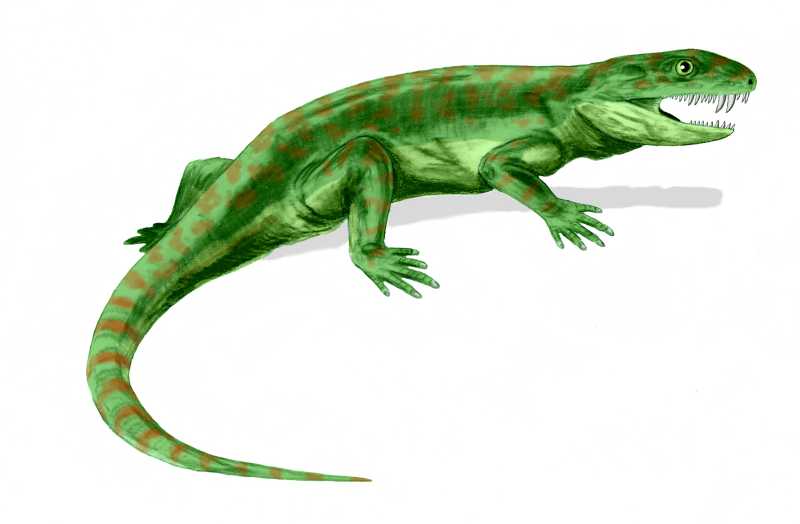
The first mammals appeared around 225 million years ago, in the late Triassic Menses. However, the story of mammals began millions of years earlier and then.
On this folio, we're going to discover how amphibians lost their dependence on h2o and evolved into two primary groups of land animals, 1 of which would include the ancestors of all of today's mammals.
On the way, we're going to run into some weird and wonderful animals, many of which are your ancestors!
Oh, and if yous think that your early ancestors were all cuddly and chimp-like, nosotros've got news for you: they really looked more like dinosaurs!
Mammal Evolution: The Story
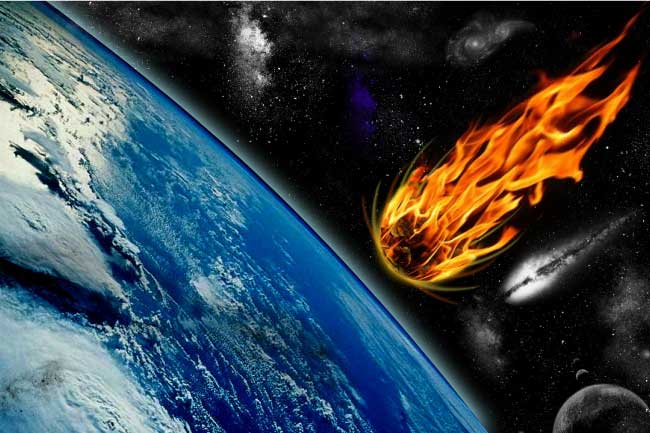
The evolution of mammals is a story that takes place over hundreds of millions of years.
In the course of the story World is devastated by not i simply three major extinction events. Each one was responsible for wiping out huge numbers of species.
Nosotros don't know where the story will stop: perhaps human will venture into infinite, or mayhap we'll end up destroying the very planet whose resources enabled us to thrive.
The future is in our hands!
… Unless a huge asteroid emerges from the depths of space on a standoff course with Globe. Information technology'south probably best not to think about that!
Mind … diddled!
This may accident your mind: lions, mice, gorillas, and every other mammal alive today – including you lot – came from just ane species of animal!
That'southward right; in but the same mode that your cousins have the same grandparents every bit you, if you lot go far enough dorsum in time, then y'all'll find a single species that gave ascent to whales, wolves, cats, bats, your grandparents, your cousins, and you!
In scientific terms, this species is the called the 'nearly contempo mutual ancestor' of mammals. This is oftentimes shortened to 'MRCA'.
So if you considered your pet cat to be a member of your family, you were – sort of – right!
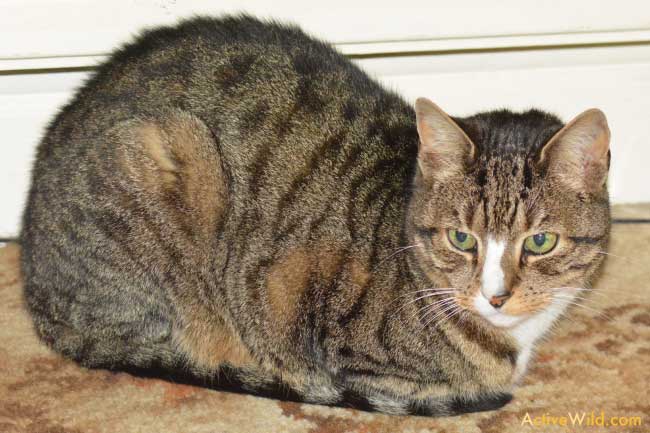
We'll meet our well-nigh recent mutual ancestors farther downwards the folio.
Leaving The Water
Amniotes
The story of mammals begins in prehistoric lakes and rivers, when amphibians first ventured onto state.
The early ancestors of both mammals and reptiles were called amniotes. These reptile-like animals evolved from amphibians. Dissimilar amphibians, amniotes could fertilize and lay their eggs away from the h2o.
Amniotes appeared around 312 million years ago in the late Carboniferous Menses of the Paleozoic Era.
The early on amniotes were small, lizard-like animals. Freed from the constraints of having to return to the h2o to breed, they could inhabit a wide range of habitats.
The amniotes soon split up into two main branches: the synapsids, and the sauropsids.
Synapsids Vs Sauropsids: Mammals Vs Reptiles
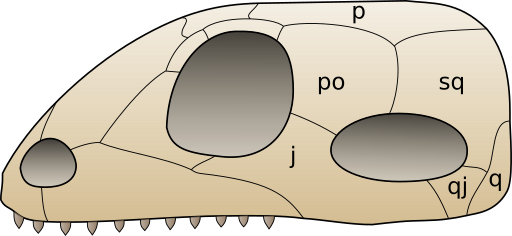
The synapsids were characterized by having a single opening behind the eye on either side of their skulls: just like today's mammals.
As you may accept guessed, you've just met your ancestors! The synapsids are the ancestors of all mammals. (Strictly speaking, mammals ARE synapsids.) Still, it would be a long time earlier the true mammals would appear.
The other main branch of amniotes was the sauropsids. These were early reptiles, and a co-operative chosen the diapsids were the ancestors of modernistic reptiles, dinosaurs and birds, too as prehistoric reptiles such equally plesiosaurs and ichthyosaurs.
(Equally you'll know if you've read our dinosaur pages, birds are the descendants of theropod dinosaurs, and many scientists consider them to exist the last remaining dinosaurs.)
Diapsids had two openings on either side of their skulls, simply like today's birds and reptiles. (Many scientists believe that although today's Testudines (Turtles, tortoises and terrapins) don't have any actress openings in their skulls, their ancestors did.)
Pelycosaurs
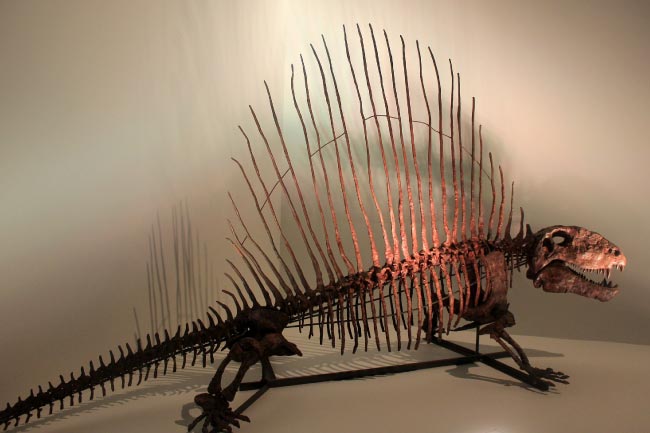
Early synapsids chosen pelycosaurs became the ascendant large land animals during the early Permian Period. An example of a pelycosaur is the dimetrodon, an noon predator that grew to over 4 yard (13 ft.) in length.
Although dimetrodon still looked very reptilian, it was more closely related to mammals.
Another pelycosaur was the Cotylorhynchus, a 3 g (10 ft.) long fauna with a huge round body and tiny head. Its legs were sprawled like a reptile, but information technology had a mammal-like unmarried opening on either side of its skull.
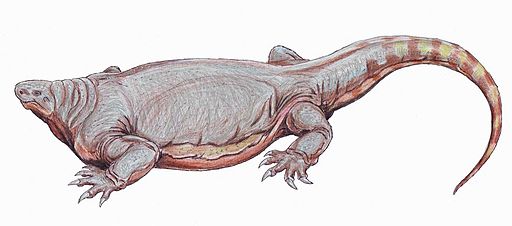
Therapsids
The pelycosaurs were replaced later in the Permian Period by another grouping of synapsids chosen therapsids.
The therapsids thrived, with different branches condign predators, constitute-eaters and burrowers.
Therapsids became increasingly mammal-like, developing legs that extended downward from their bodies rather than sprawling out sideways similar those of reptiles.
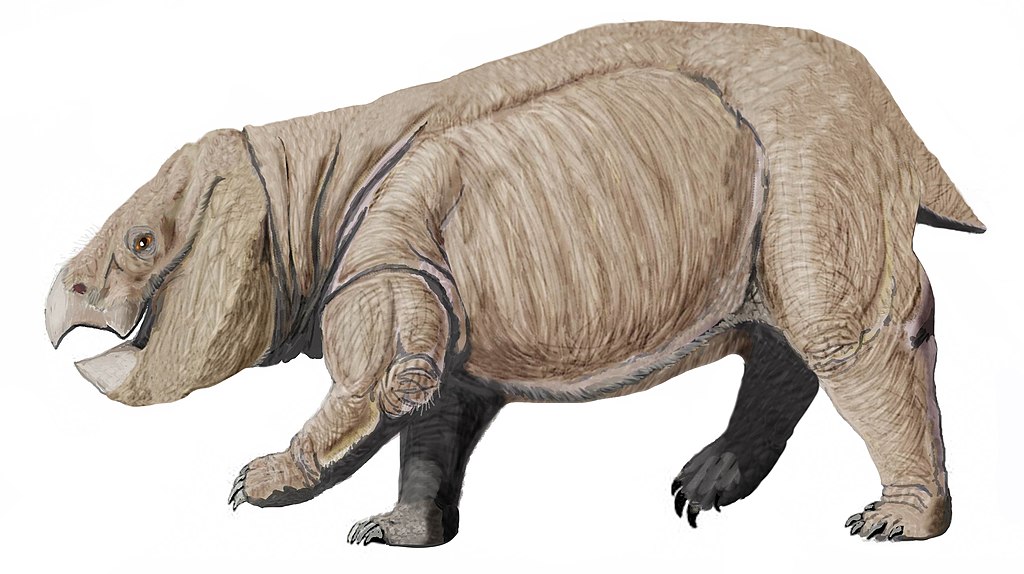
In the late Permian, therapsids called Dicynodonts became the dominant land animals. Dicynodonts – whose name means 'two dog tooth' – were an extremely varied group of animals. Some, such equally Placerias, were big herd animals, while others were small burrowers.

Mammal Evolution Clues In Poo!
It's possible that Dicynodonts were endothermic (warm-blooded), and that they had hair. Both of these are mammalian characteristics, as you'll know if you've read the outset part of this series: What Is A Mammal?
Scientists know Dicynodonts had hair by studying coprolites (y'all guessed it, fossilized poo) from Permian predators that preyed on Dicynodonts.

Permian–Triassic Extinction Event
252 one thousand thousand years ago, World was rocked past the Permian–Triassic Extinction Event. It was, and still is, the world'due south most devastating extinction event. It is known every bit 'The Groovy Dying'.
The Permian–Triassic Extinction Event marked the end of the Paleozoic Era and the starting time of the Mesozoic Era.
Amazingly, information technology was even more destructive than the afterwards Cretaceous–Paleogene extinction outcome, which was responsible for wiping out the dinosaurs. (We'll get to them later!)
Upward to 75% of all species, including many of the early mammal-like animals, became extinct during the Permian–Triassic Extinction Consequence. Possible causes for the extinction upshot include an asteroid strike and mass volcanic eruptions.
Some Dicynodonts survived, including the Lystrosaurus, a pig-sized herbivore that had a bill and two tusk-like teeth. Lystrosaurus was the about common land animal of the Early Triassic.
Placerias too made it through the mass extinction.

Cynodonts
Other therapsids called cynodonts had appeared in the Permian period and were now diversifying. The cynodonts were the ancestors of all modern mammals.
Thrinaxodon was a dog-sized, carnivorous cynodont that lived in what is now Due south Africa. Information technology had a mammalian lower jaw and teeth that had specific functions (due east.g. some were for cutting, others were for biting or chewing – but like those of a mammal).
There is also evidence that thrinaxodon had hair and whiskers. All of these are characteristics of mammals.

Trucidocynodon was some other predatory cynodont. The size of a modernistic day large true cat, Trucidocynodon was one of the first mammal-type animals with adaptions for running.
Traversodontidae was a family of herbivorous cynodonts that appeared in the Triassic Period. They were widespread, having been found in Europe, Africa and the Americas, but disappeared in the Early on Jurassic.
Rise Of The Dinosaurs … And The True Mammals
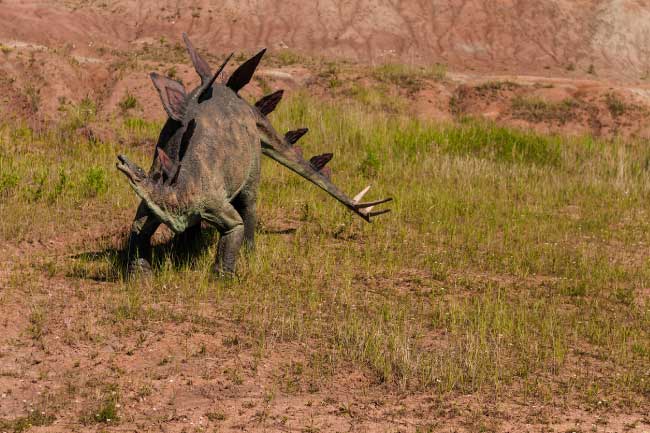
The Mesozoic Era is known as the 'Age of Reptiles'. Every bit you may have guessed, things didn't go as well well for the early on mammals during this time!
During the course of the early Triassic Period of the Mesozoic Era, sauropsids called Archosaurs established dominance on the country.
There were 2 chief branches of archosaur: Pseudosuchia, (early crocodile-like animals and the ancestors of modernistic crocodiles) and Ornithosuchia.
Ornithosuchia included the dinosaurs and pterosaurs. With these guys around, the bigger early mammals didn't stand much of a hazard, and the larger cynodonts became extinct.
The Outset Mammals
However, as dinosaurs became dominant, the therapsids continued to evolve.
The surviving therapsids were small, only increasingly mammal like. Effectually 225 million years ago, the kickoff truthful mammals began to appear.
The start mammals were modest, nocturnal insectivores (insect eaters), like in appearance to today'due south rodents.
Monotremes, Marsupials & Placental Mammal Evolution
The early on mammals were egg-laying animals. The marsupials and placental mammals (both of which give nascency to live immature) would branch off subsequently, leaving today's v monotreme species as the just modern egg-laying mammals.
- You tin find out more about the dissimilar types of mammal hither.
Sinoconodon rigneyi tin either be thought of as 1 of the first known mammals, or a fellow member of an intermediate group of animals chosen Mammaliformes. It lived in China around 193 million years ago.
It was small and although rodent-similar, was still a very early mammal: information technology had teeth were continually replaced (unlike those of a modernistic mammal), and it almost certainly laid eggs.
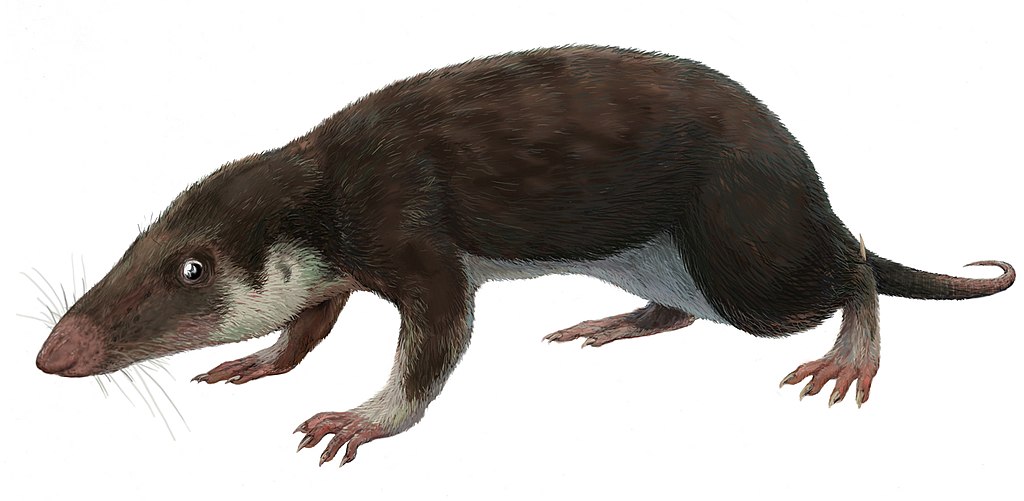
Morganucodon watsoni is another contender for being the first mammal. The first Morganucodon fossils were constitute in Wales, simply others take since been found in other parts of the globe. Information technology was an egg-laying animal of around 10 cm (4 in.) in length not including its tail.
Shrew-similar in appearance, Morganucodon watsoni fed its immature with milk, and probably had hair.
Triassic-Jurassic Extinction Event
The first mammals survived the Triassic-Jurassic extinction event that occurred 201.3 million years ago.
This mass extinction wiped out around half of the World'southward species. Almost of the archosaurs that weren't dinosaurs became extinct, every bit did many therapsids.
The dinosaurs, early crocodiles and pterosaurs survived. Information technology was dinosaurs that would rule the Jurassic and Cretaceous periods.
Mammal Evolution And The Nocturnal Clogging
The success of the dinosaurs meant that almost mammals became nocturnal and insectivorous (insect-eating). This is put forward as the underlying reason behind many mammalian characteristics – a theory known every bit the 'Nocturnal Bottleneck'.
Hunting at night requires fantabulous senses of smell, hearing and touch. Having external ears and whiskers would take been extremely beneficial to small animals living alongside dinosaurs.
An insect-based nutrition would accept required teeth that could grab and crush nimble casualty.
Being warm-blooded would have enabled mammals to chase at night when information technology would have been besides cold for cold-blooded reptiles.
Predatory Early Mammals

Not all mammals of the Jurassic and Cretaceous Periods were pocket-size, skulking insectivores.
Fossil testify suggests that some Jurassic mammals, such as Castorocauda and Haldanodon were semi-aquatic fish-eaters.
Repenomamus, which lived in China during the Cretaceous period, was ane of the largest mammals of its time. Reaching xiv kg (31 lb.) – effectually the size of an average dog – this predatory mammal preyed on small-scale dinosaurs.
We know this considering a repenomamus fossil was found with the remains of a dinosaur in its stomach! (Although, of class, repenomamus could take been a scavenger, rather than an active predator.)
Other Cretaceous mammals could glide, some had quills, and some were agile during the solar day.
The Cease Of The Dinosaurs
Although the dinosaurs had been an extraordinarily successful group of animals, dominant for many millions of years, their reign eventually came to an end.
The end of the dinosaurs –and of the Mesozoic Era – came with the Cretaceous–Paleogene Extinction Result, which occurred around 66 million years ago. This consequence – idea to have been caused by an asteroid bear on – caused the extinction of 75% of all species on Globe.
Yous tin find out more about the terminate of the dinosaurs hither.
It wasn't only the (non-avian) dinosaurs* that were affected. Pterosaurs and plesiosaurs and mollusks such as ammonites became extinct. Many mammals, birds, fish and plants were also wiped out.
* Birds – which many scientists today consider to be dinosaurs – were the only dinosaurs to survive.
The Cenozoic Era: Age Of Mammals
The Cretaceous-Paleogene Extinction Event marked the end of the Mesozoic Era and the beginning of the Cenozoic Era.
The Paleogene Period And The Rise Of The Mammals
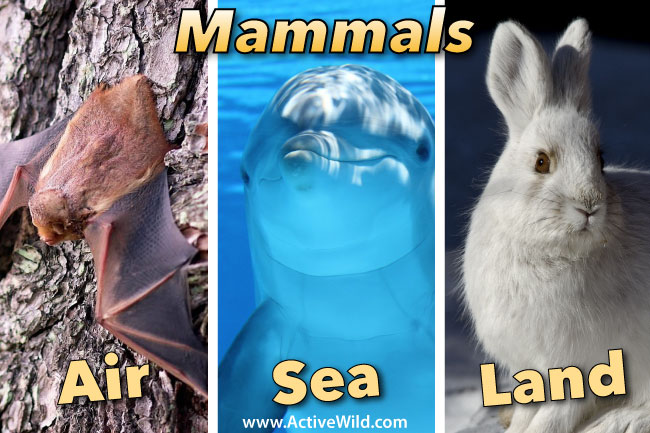
The outset period of the Cenozoic Era was the Paleogene Period. At present, with the dinosaurs out of the way, the scene was set for the ascension of the mammals.
The surviving mammals were small, shrew-like animals. However, at present there was little or no reptilian competition, they soon diversified.
Mammals experienced an adaptive radiation that would see them filling many new niches, non merely on land, just also in the water and in the air.
(An adaptive radiation is when many species spring from a single ancestor following a favorable modify in their environment.)
Birds too underwent an adaptive radiations at this time.
In a relatively short period of time, mammals came to dominate about every environment on land. During the Paleogene and Neogene Periods, all of the electric current mammalian orders were established.
The balance, as they say, is history. Whereas the Mesozoic Era is known as the 'Age of Reptiles', the Cenozoic Era is known every bit the 'Age of Mammals'. (It's also known as the 'Age of Birds' due to their dominance of the skies.)
Mammal Evolution: Conclusion
In this commodity we've traced the evolution of mammals from the amniotes to the adaptive radiation that saw mammals become the dominant state animals at the beginning of the Cenozoic Era.
The amniotes were descended from amphibians. Having lost their dependence on water, they split into two main branches. I branch would become the mod reptiles and the birds, the other the mammals.
The ancestors of the mammals were at 1 time the dominant animals on country. However, after two devastating extinction events, the early mammals' hold on the land was weakened.
During the Triassic Flow the reptiles became dominant. The dinosaurs became ane of the most successful groups of animals the world has ever known.
Withal, it was during the Triassic Period that the common ancestor of all mammals appeared. It is likely that mammalian characteristics were shaped during the time the early mammals shared Globe with the dinosaurs.
The Cretaceous–Paleogene Extinction Issue spelled the stop of the dinosaurs and the beginning of the Cenozoic Era; the 'Age of Mammals'.
We promise that you've enjoyed this journey into your dim and distant past. If you liked this article, and so be sure to tell your friends nigh information technology by sharing information technology on social media using the buttons at the top of the page. Teachers and parents are too welcome to link to this folio from their own websites.
Now you lot know all about mammal evolution, check out the other pages in this serial:
- Go to Part Ane: Mammals: An Introduction
- Go to Part Two:What Is A Mammal?
- Go to Part 3:Types of Mammals
- Is a bird a mammal?
- Are sharks mammals?
- Is a dolphin a mammal?
Source: https://www.activewild.com/mammal-evolution/
Posted by: leewelesepind.blogspot.com

0 Response to "During Which Era Did Mammals Become The Dominant Land Animals?"
Post a Comment